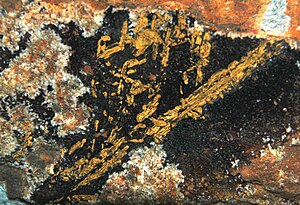Mines Museum Of Earth Science
In 2003, a space designed specifically for the museum was built as part of the GRL (General Research) building on campus. This 15,000 square foot space is the current home of the museum with more than 2,500 fossils, gemstones, meteorites, minerals, and mining artifacts. The name of the museum was changed from, the Colorado School of Mines Geology Museum, to Mines Museum of Earth Science, in 2019 during rebranding initiated by Executive Director, Renata Lafler.
Significant objects in the Museum's collection include: the Miss Colorado Crown, two lunar samples from the Apollo 15 and 17 missions, the Allison-Boettcher gold collection, the Wolcott silver pitcher and tray, an apatosaurus femur, an impressive assortment of fluorescent minerals, and the most comprehensive public collection of Colorado minerals in the world.
Mines Museum is open seven days a week and admission is FREE.
Gallery
-
Native gold after sylvanite lining fracture in phonolite, Cripple Creek mining district. Specimen at the museum.
See also
References
- ^ "InK – Issue #1 (Nov. 2019)". Colorado School of Mines. Retrieved June 20, 2020.
External links
- Museum website
- A hidden gem in Golden, Denver Post, 02/18/2016
